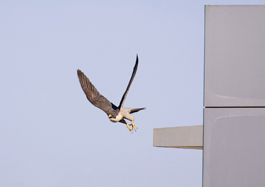home | metro santa cruz index | news | santa cruz | news article

Photograph by Nick Dunlop
Freebird: Clara, a peregrine falcon nesting on San Jose's City Hall, may be officially delisted by the state along with the rest of her ilk.
Higher Calling
How UCSC biologists helped bring back the peregrine falcon.
By Steve Hahn
The peregrine falcon, nearly wiped out in the late 1960s by the pesticide DDT, now boasts a population so healthy that state wildlife officials are considering taking it off the endangered species list, and environmentalists are actually supporting the decision.
For UCSC Predatory Bird Research Group coordinator Glenn Stewart, a key player in the species' rehabilitation, it's been a long road. It all started in the late '60s, when Stewart and other biologists began to notice that eggshells from falcons and other large birds of prey were becoming thinner due to DDT pollution. Newborn chicks were dying in droves. By 1970, only two pairs of peregrine falcons were successfully breeding in California, down from at least 100, and the species was extinct east of the Mississippi.
It would be an unprecedented gamble, but the stakes were high. A group of biologists, many from UCSC, embarked on a captive breeding program.
"Back in those days, birds of prey had never been bred in captivity, and many people said it would never work," Stewart said. "Those efforts were eventually successful, and people ended up emulating what we did. Today, breeding falcons in aviaries is very common."
The tale Stewart tells describes a mixture of hard-nosed conservation biology and extreme sports. Once the youngsters had hatched, their human protectors would set out on the epic quest of placing them back in natural nests built by the wild adult falcons.
"Some of these UCSC biologists were scaling 1,000-foot cliffs, going back and forth to falcon nests in order to manage them in the wild," remembers Stewart. "Now we've got peregrine falcons so common, we have webcams showing them on our website. So there you go."
In 2006, biologists officially recorded almost 250 pairs of the falcons in California, but they estimate there are actually closer to 300 (it's hard to survey the entire state). This amazing rebound led the federal government to take the peregrine falcon off the endangered species list in 1999. Now, the California Department of Fish and Game is considering following suit, but it wants to hear from the public first.
Stewart and others at UCSC support the delisting. "For the people involved in this since the 1970s, we feel it's an accomplishment we should celebrate," says Stewart. "There was a long period of time when you just never saw one in the wild. Now I see them fairly commonly over Santa Cruz. My son played baseball on the high school team for a while, and at his games I would look up and I could see the falcons flying above."
Send a letter to the editor about this story.
|
|
|
|
|
|